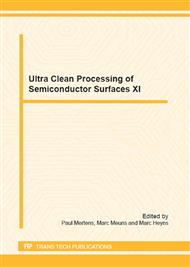p.181
p.185
p.191
p.195
p.198
p.201
p.205
p.209
p.213
CO2-Dissolved Water Cleans for 2xnm-Node Silicon Devices in a Single Wafer Megasonic System
Abstract:
Megasonic cleans have been applied to remove defects such as particles and polymer/resist residues in silicon wafer fabrication of IC devices. However, with the shrink of device technology node, megasonic cleans are being challenged to maintain high cleaning efficiency promoted by streaming force of stable cavitation for the smaller particles without producing pattern collapse caused by violent implosions of transient cavities [. S. Kumari et al. reported that CO2-dissolved water (CO2 DIW) was potentially able to suppress wafer damage during megasonic exposure by minimizing unrestrained explosion of transient cavities. This is accomplished through the study on Sonoluninescence (SL), the phenomenon of release of light when liquid is irradiated by sound wafers of sufficient intensity, as a sensitive indicator of cavitation events [2, . This paper compares the effects of CO2 dissolution on particle removal efficiency (PRE) and pattern collapse in a range of megasonic power with >100nm-size Si3N4 particles and 2xnm node line/space-pattern, respectively to N2-gasified water (N2 DIW).
Info:
Periodical:
Pages:
198-200
Citation:
Online since:
December 2012
Authors:
Price:
Сopyright:
© 2013 Trans Tech Publications Ltd. All Rights Reserved
Share:
Citation:


